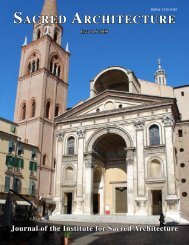Download Issue PDF - The Institute for Sacred Architecture
Download Issue PDF - The Institute for Sacred Architecture
Download Issue PDF - The Institute for Sacred Architecture
Create successful ePaper yourself
Turn your PDF publications into a flip-book with our unique Google optimized e-Paper software.
Articles<strong>for</strong> Catholic use or otherwise. 10Although Venturi is hailed as breakingopen the possibility of mainstreamacademic use of traditional architectural<strong>for</strong>ms, the coherent initial phaseof postmodernity in architecture lasted<strong>for</strong> only a few years, and was imbuedwith a modernist sense of irony andwit intended to remind the viewer ofthe continued relation of new buildingsto the break with architectural traditionespoused by modernism. Onefinds there<strong>for</strong>e in this postmodernisma certain kind of faddish relativismwhich made no specific claims <strong>for</strong> theclassical tradition other than as an interestingHegelian antidote to the univocityof modernism. Simply stated,postmodernism was not what we knowof today as New Classicism. However,by breaking the stranglehold of modernismand its extreme prohibitionsagainst any literal use of traditional<strong>for</strong>ms, it shattered the architectural professioninto many shards, one of whichwas picked up by those believing thatcontinuity with a legible, coherent classicalarchitectural tradition, sometimescalled “canonical classicism,” was anaim worth pursuing. From this postpostmodernlineage grows an evensmaller subset ofarchitects whohave chosento specialize inchurch architecture.In the UnitedStates, one cannot address theemergence ofNew Classicismin Catholic ecclesiasticalarchitecturewithoutunderlining theimportance ofarchitect AllanGreenberg. Anative SouthAfrican born in1938, he learnedtraditional architecturalmethodswhile in architectureschool inJohannesburg,though his earlywork was withleading modernistsin Europe.In 1963 he cameto the UnitedStates, earning a master’s degree atYale University in 1965. By the early1970s he had encountered the critiqueof Yale colleagues Robert Venturi andDenise Scott Brown, and became associatedwith an architectural movementdominated by architects known as“the Grays,” those who rejected modernism’s“black and white” rejectionof the use of traditional architectural<strong>for</strong>ms. By the early 1980s, he was establishedas one of the few architects inthe world willing to design buildingsusing canonical classicism, developinga successful practice largely dominatedby private homes and institutionalbuildings. While not known <strong>for</strong> churchdesigns, Greenberg’s office becamesomething of an unofficial postgraduateacademy, taking in recent architectureschool graduates with an interestin classical architecture and teachingthem how to make their self-taughtand postmodern designs convincinglycanonical. Two of today’s leading classicalchurch architects, Duncan Stroikand James McCrery, worked as youngdesigners in Greenberg’s office.But even the work of such a committedcanonical classicist as DuncanStroik depended in part upon the appearanceof postmodernism in secularacademia. As a 1984 graduate from theSchool of <strong>Architecture</strong> at the Universityof Virginia, Stroik’s education cameunder the deanship of architect JacquelinRobertson, a man deeply involvedwith the postmodern movement of the1980s and known <strong>for</strong> bringing leadingpostmodernist architects like AllanGreenberg, Robert A. M. Stern, andLeon Krier to the school to discuss architecturalpractice. Robertson’s 1982conference on postmodernism broughttogether twenty-five leading Americanarchitects and became the book knownas <strong>The</strong> Charlottesville Tapes. Historiansand theorists like Carroll WilliamWestfall gave the embrace of classicismand urbanism a deep theoretical base.This short-lived embrace of postmodernarchitecture at the University ofVirginia nonetheless created at leastsome alumni who would embrace theNew Classical mode of architecture.Almost at the peak of the postmodernmovement in the mid-1980s, Stroikcontinued to Yale University to earna graduate degree, where under thedeanship of Thomas Beeby, professorslike Robert Venturi, Andres Duany,and Elizabeth Plater-Zyberk continueda postmodern approach to architectureand urbanism.But Stroik credits his awakening asa classical architect to the influence ofCathedral of Mary Our Queen, Baltimore20 <strong>Sacred</strong> <strong>Architecture</strong> <strong>Issue</strong> 21 2012Photo: wikipedia.org










